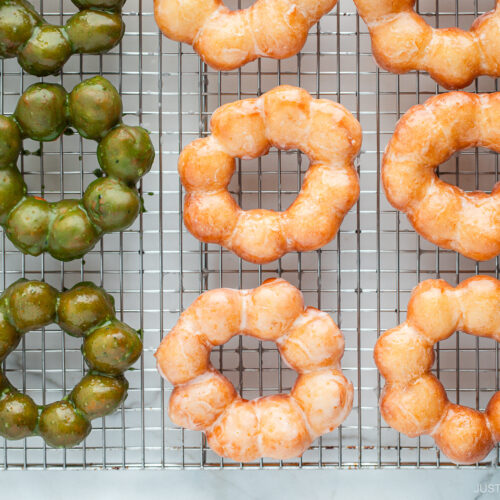
Pon de Ring Donut
Make your own Pon de Ring Donut at home just like Japan's Mister Donut with my copycat recipe! They are soft, airy, bouncy, and chewy all at once with a unique mochi-like texture. Enjoy them with either a classic or matcha glaze.
Servings: 24 donuts
Calories: 193kcal
Ingredients
- 6 Tbsp unsalted butter
- 2 large eggs (50 g each w/o shell)
- 1 cup whole milk (heated to 110ºF or 43ºC, slightly warmer than body temperature; do not use low-fat or skim milk)
- 1 tsp instant yeast
- ¼ cup granulated sugar
- 1 tsp pure vanilla extract
- 320 g tapioca flour (2½ cups + 2½ Tbsp; please weigh your flour; if you don't have a kitchen scale, see how to measure flour with a measuring cup)
- 180 g all-purpose flour (plain flour) (1¼ cups + 1 Tbsp; please weigh your flour; or learn how to measure flour with a measuring cup)
- ½ tsp Diamond Crystal kosher salt
- 4 cups safflower oil (for deep-frying; see Notes for the amount of oil to use)
For the Glaze
- 2 cups confectioners’ sugar
- ¼ cup whole milk
- ½ tsp pure vanilla extract
- 1 Tbsp matcha green tea powder (optional)
Instructions
- Gather and measure all the ingredients. I strongly encourage you to use a kitchen scale to weigh the flours. Prepare 24 squares of parchment paper measuring 4 x 4 inches (10 x 10 cm). I DO NOT double or triple this recipe. Make in batches, if needed.
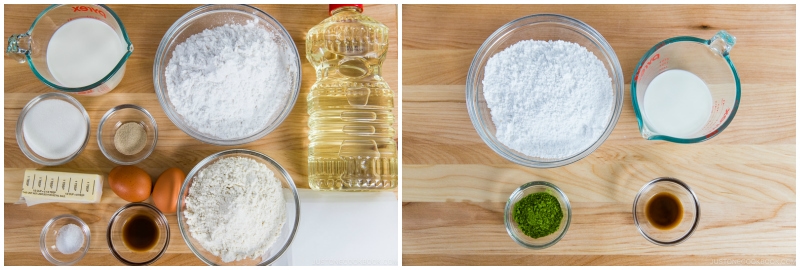
- Melt 6 Tbsp unsalted butter in the microwave or in a saucepan on the stove and let it cool slightly. Crack 2 large eggs (50 g each w/o shell) in a bowl and beat them with a whisk. Set aside.
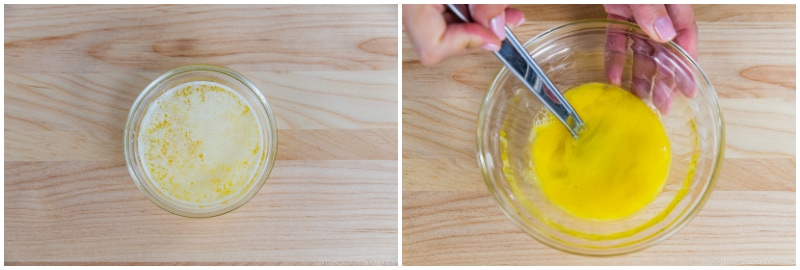
- Combine 1 cup whole milk (110ºF or 43ºC—slightly warmer than body temperature) and 1 tsp instant yeast in the bowl of a stand mixer (or large mixing bowl). Then, take ½ tsp sugar from the ¼ cup granulated sugar you measured earlier and add it to the milk and yeast. Whisk the mixture well. Set aside for 5–10 minutes. Note: If you wonder why I hydrated the instant yeast, please read the post.

- Sift 320 g tapioca flour (2½ cups + 2½ Tbsp) and 180 g all-purpose flour (plain flour) (1¼ cups + 1 Tbsp) through a fine-mesh sieve into another large mixing bowl. Whisk to combine and set aside.

To Mix the Ingredients
- Fit the stand mixer with a flat beater attachment. Add the rest of the sugar and the beaten egg to the milk mixture.
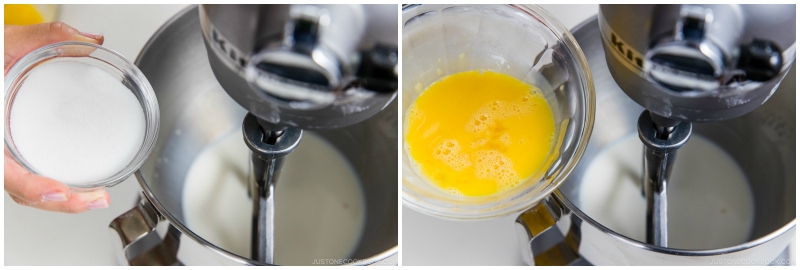
- Add the melted butter and 1 tsp pure vanilla extract to the milk mixture.
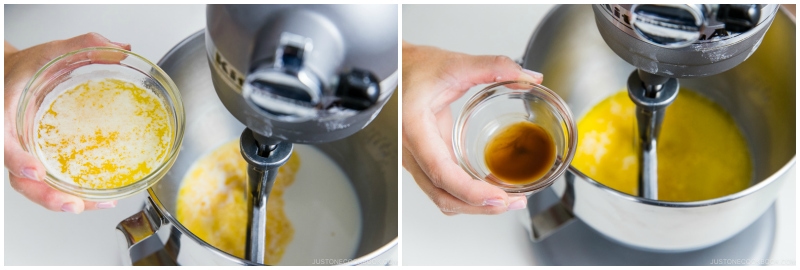
- Stir on low speed (Speed 2 on my KitchenAid Professional HD stand mixer) for 1 minute to combine. You could also stir it with a wooden spoon.
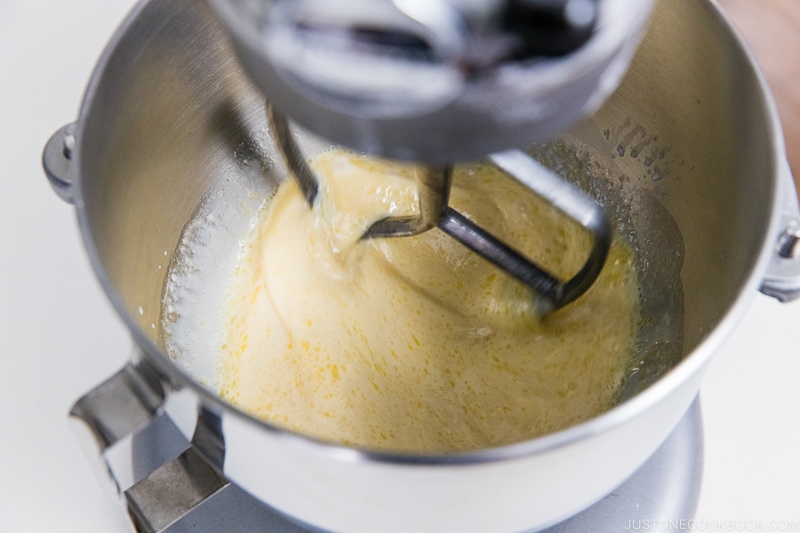
- Add roughly 2 cups of the flour mixture and stir on low speed (Speed 2) until well combined.
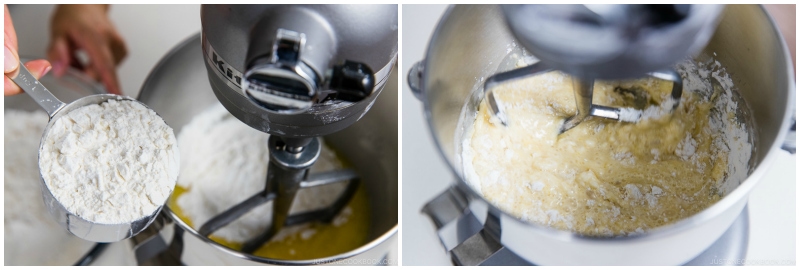
- Keep the stand mixer running on low speed and add ½ tsp Diamond Crystal kosher salt and the remaining flour mixture, one scoop at a time. The dough mixture will thicken. Set aside the mixing bowl that the flour was in for the next step (you‘ll put the dough in it).
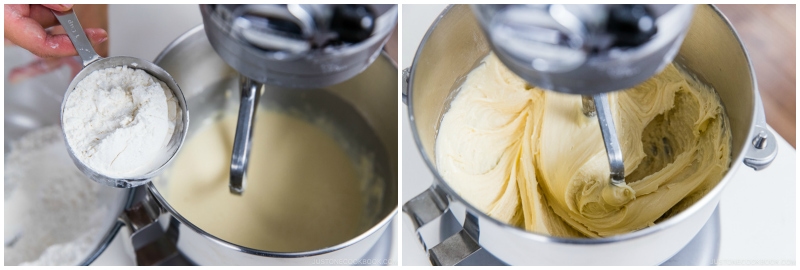
To Knead the Dough
- Now, knead the dough at medium-high speed (Speed 6) for 3–4 minutes, or until smooth and elastic. This is a wet and sticky dough, so do not add more flour. Tip: Kneading develops the structure of the dough by folding and stretching the gluten strands. Hand Kneading: Knead by hand for 5–6 minutes. It’s hard to knead this wet dough by hand. You can add 1–2 tablespoons of flour if it’s too wet to handle, but do not add any more than that.
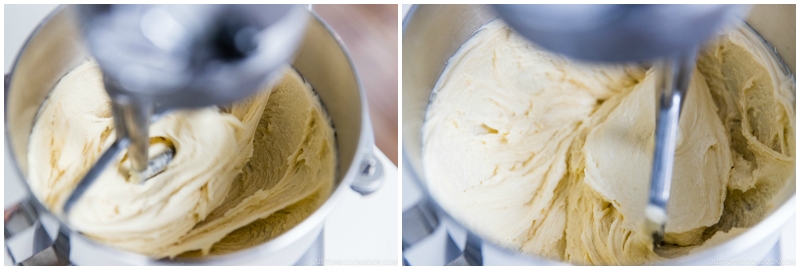
- While the mixer is kneading the dough, add a little oil to the large mixing bowl that held the flour mixture and grease it with a paper towel.
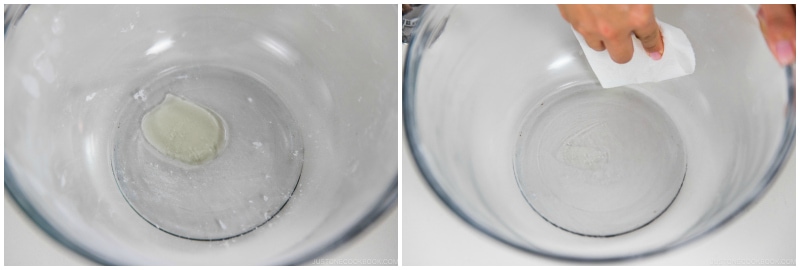
- Stop the mixer after 3–4 minutes or when the dough is smooth. It should be sticky and stretchy when you remove the flat beater from the mixer.
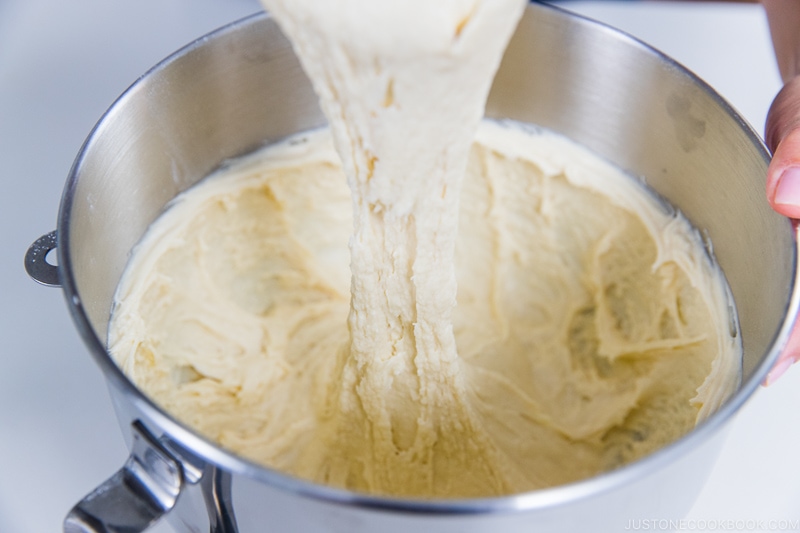
To Proof the Dough (Bulk Fermentation)
- Scrape down the dough from the sides of the bowl with a dough scraper or pastry card. Collect it into one big mass, then gently transfer it to the greased bowl. The key is to make a smooth surface on the dough so that it rises well. Loosely cover the bowl with plastic wrap (or a clean shower cap) and place it in a warm environment to rise until doubled, about 70–80 minutes. I use the Proof setting of my oven at 100ºF (38ºC). I place a bowl of warm/hot water inside the oven, but away from the dough, to keep the environment moist. Tip: Make sure the proof temperature is not too high. If the dough gets too warm, it will ferment too quickly (or overferment) and impair the flavor.
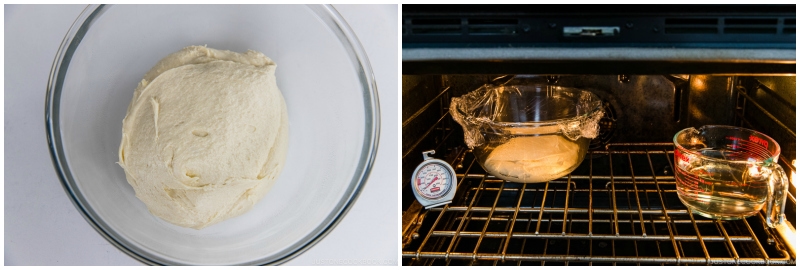
- After 70–80 minutes, pour 4 cups safflower oil into a Dutch oven or heavy-bottomed pot (see Notes for how much oil to use). Set up a cooking thermometer, if you have one. Set the alarm to a low of 325ºF (168ºC) and a high of 350ºF (177ºC). Tip: I use ThermoWork’s ChefAlarm. A clip attaches the probe to the side of the Dutch oven, holding it securely in place.
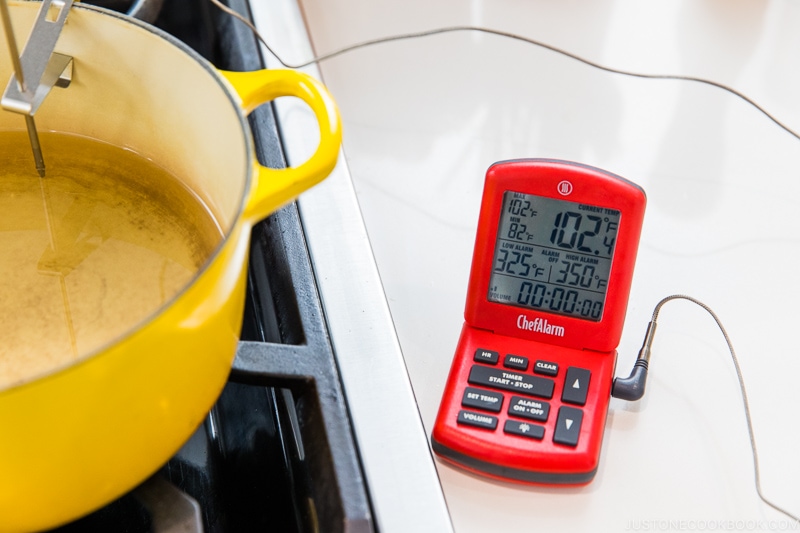
- In a medium bowl, combine 2 cups confectioners’ sugar, ¼ cup whole milk, and ½ tsp pure vanilla extract. Whisk it really well until there are no lumps of powdered sugar. Keep the matcha powder to the side for now.

- The image shows that the dough has doubled in size after 75 minutes of proofing.
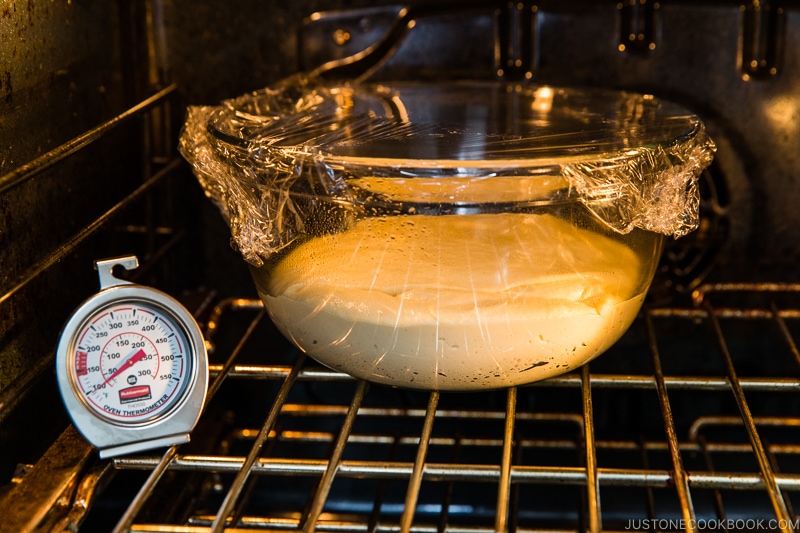
To Roll the Dough Balls
- Prepare 1–2 Tbsp of all-purpose flour and put it at the corner of your work surface. Lightly flour the work surface and your hands.
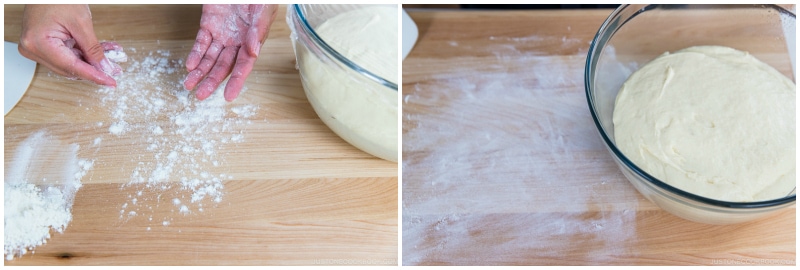
- Transfer the dough with the dough scraper to the lightly floured surface. Sprinkle some flour on top of the dough and press it down with your hands to release any air bubbles.
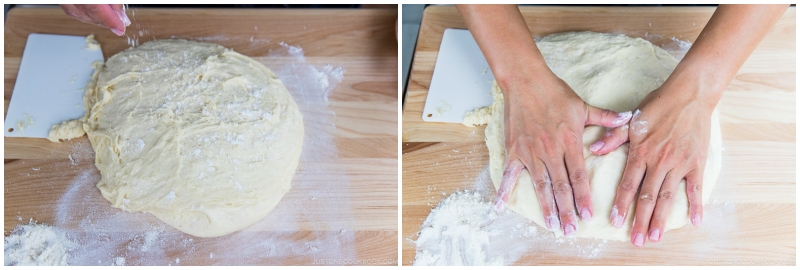
- Use the dough scraper to form the dough into a rough log shape. Cut the log into two equal pieces.
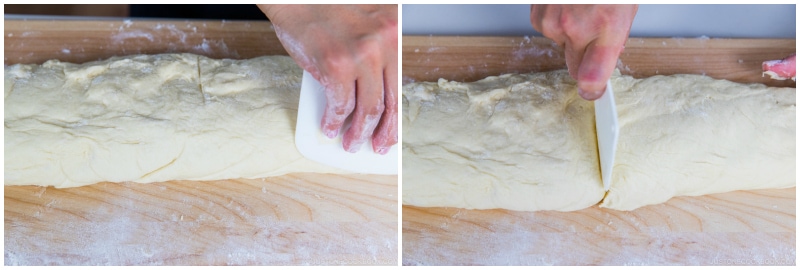
- Set one piece of dough on your work surface. Shape the other piece into a ball and cover with plastic wrap. Cut the piece on your work surface into quarters and roll them into balls. Work with one dough ball at a time, and keep the other balls under plastic wrap so they don‘t dry out.
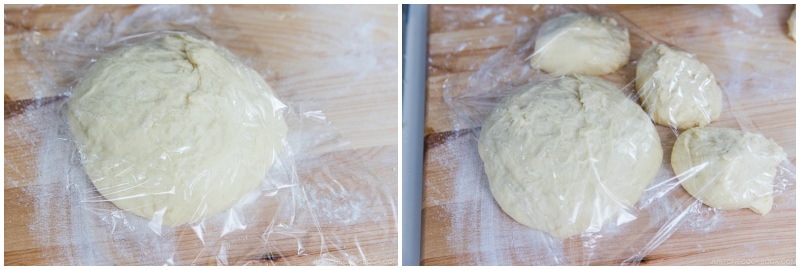
- Each dough ball will make roughly 3 Pon de Ring donuts. Using the dough scraper, cut the first dough ball into 24 small balls. Each ball should be ½–¾ inch (1.5 cm) in diameter and weigh 5 grams.
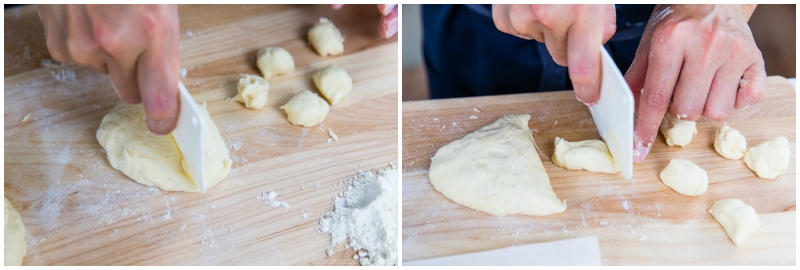
- Roll each ball between your hands, but try not to spend too much time. Overkneaded dough often results in a hard crust and a dense, dry interior. Since the dough is very sticky, the dough scraper is very helpful for picking up each piece of dough.
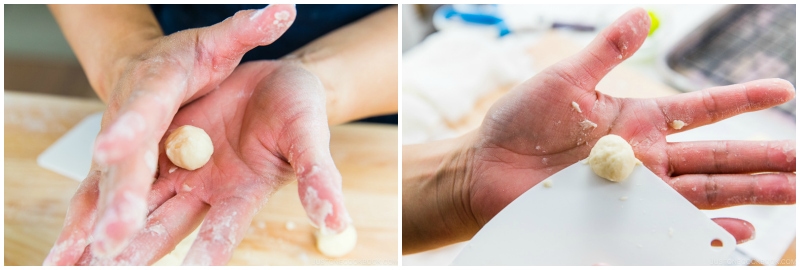
To Form the Donut Rings
- Now, form the donuts. You will need 8 balls to make each Pon de Ring donut. Use the dough scraper to transfer one ball at a time to a parchment square, forming a ring as you go. Make sure the balls are connected.
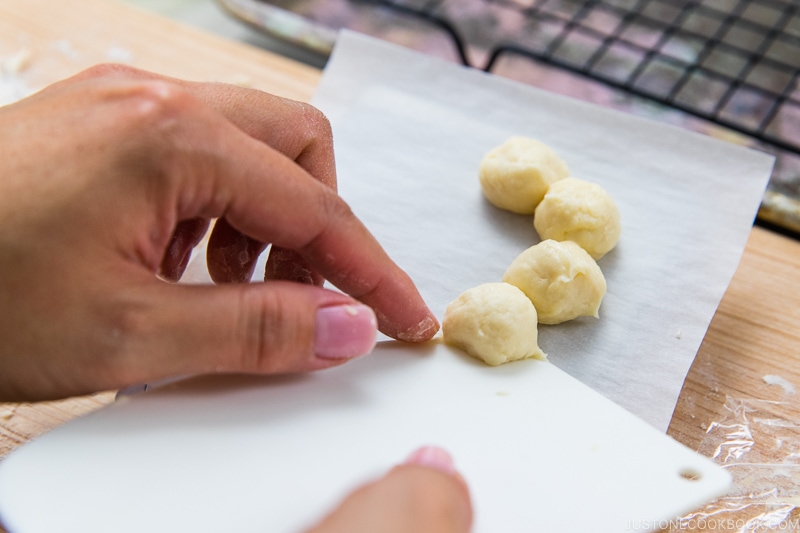
- Each Pon de Ring should weigh about 40 grams (8 balls at 5 g each).
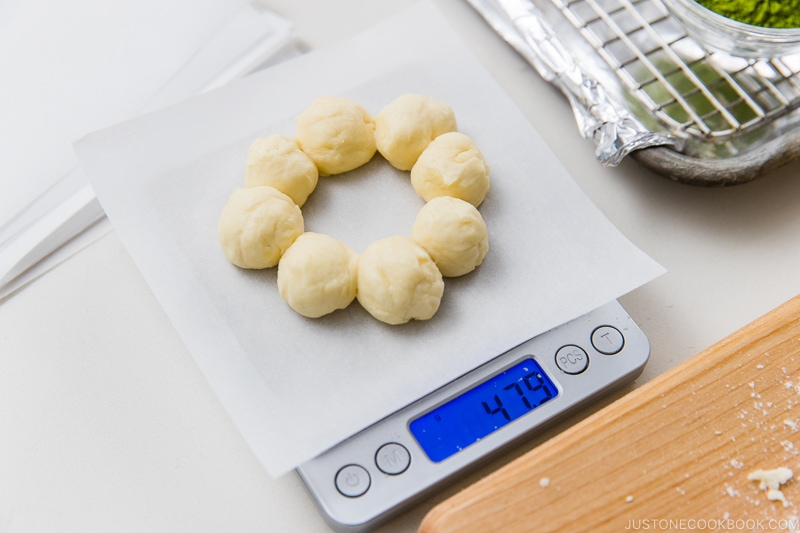
- Continue forming the rest of the donut rings.
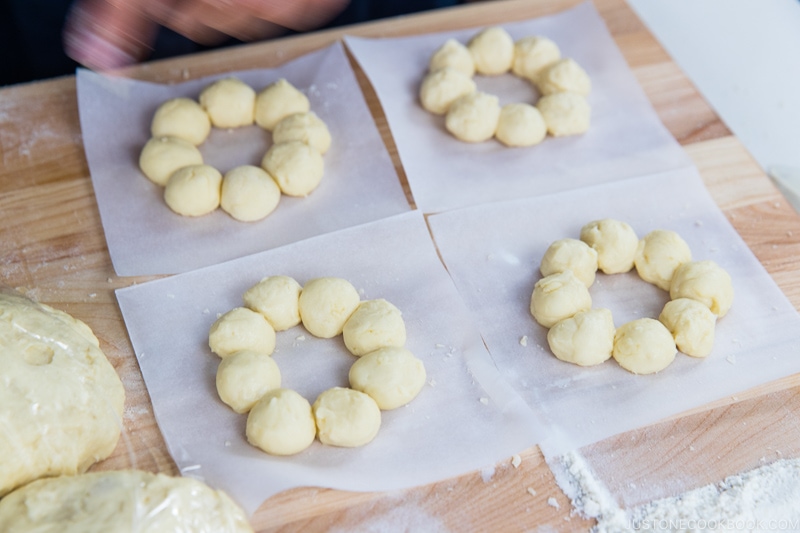
- Dab a bit of water with a pastry brush where each ball attaches to the neighboring one. This will keep the balls from separating in the hot oil. Cover the donuts with a damp paper towel or light cloth (make sure it’s not heavy) and let them rest to proof for 15–20 minutes. Tip: If you are taking a long time, it’s very helpful to work with a partner or keep the donuts in the refrigerator to slow down the proofing so the dough doesn't overproof.
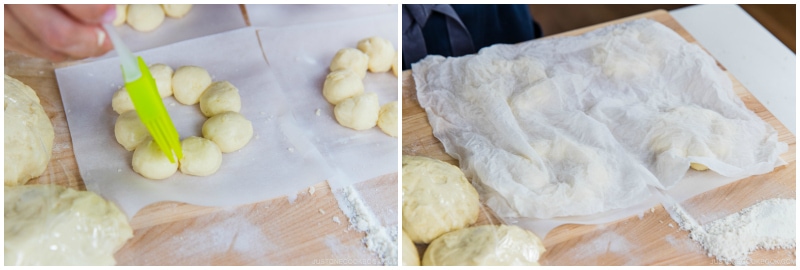
To Fry
- When you’re finishing up with the last batch of dough, start heating the oil in the Dutch oven to 350ºF (177ºC). Line one baking sheet with a paper towel. Line a second baking sheet with parchment paper and put a wire rack on top.
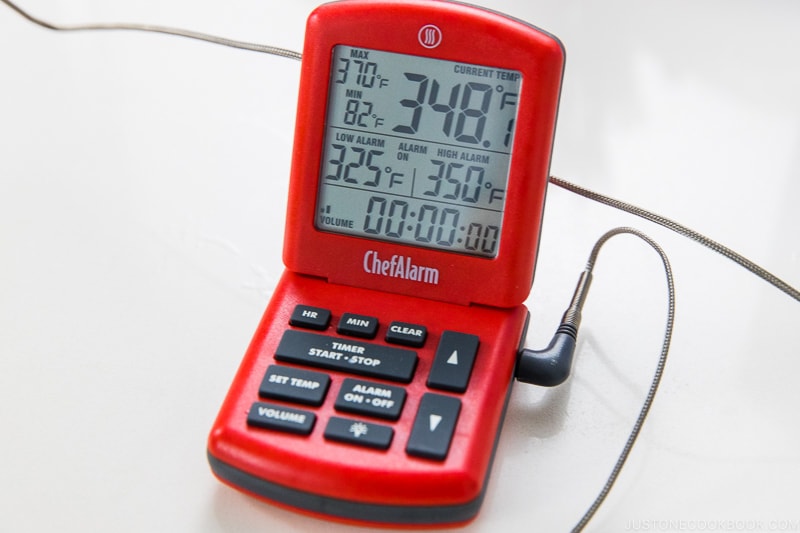
- Pick up one parchment square with a donut ring on top. Using your hand or fine-mesh skimmer (the kind that has a flat mesh), carefully place the donut with the parchment paper into the hot oil.
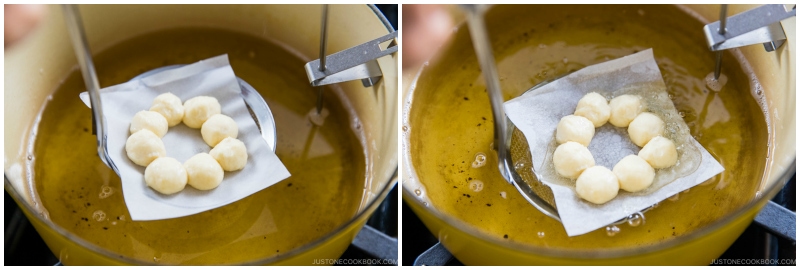
- Let go of the donut and paper and set a timer for 1 minute 15 seconds for the first side. Tip: Only add enough donuts for a 5–10 degree drop in temperature. I only fry 2 donuts at a time. If the oil cools down too much, the donuts won’t fry properly.
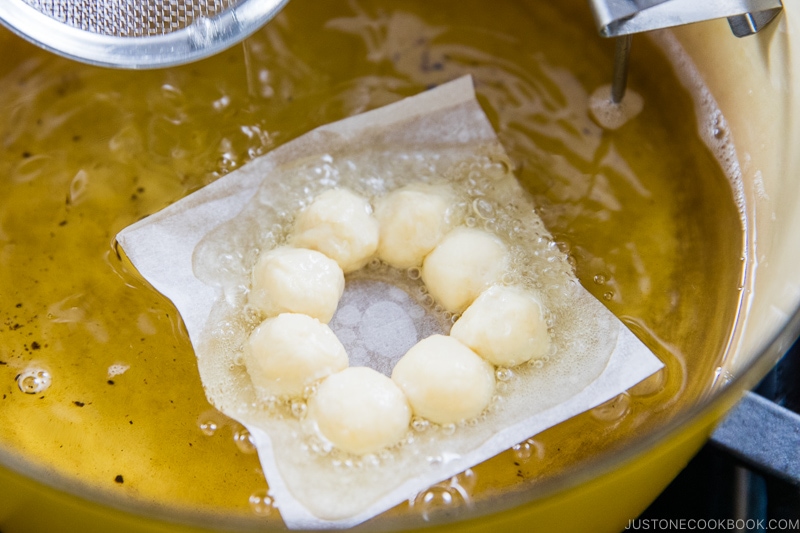
- When the timer beeps, flip the donuts quickly using chopsticks or tongs. Fry the second side for 45 seconds; set a timer. Using tongs or chopsticks, carefully remove the parchment square from the donut and discard.
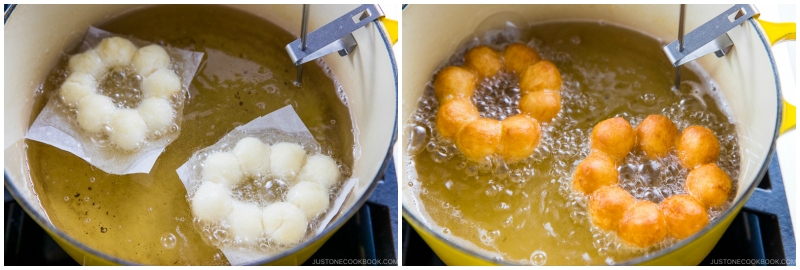
- When the 45-second timer beeps, scoop up the donuts with the skimmer or tongs and drain the oil well. Then, transfer to the paper towel to drain any extra oil. Glaze the donuts while you continue frying the remaining donuts (see the next step).
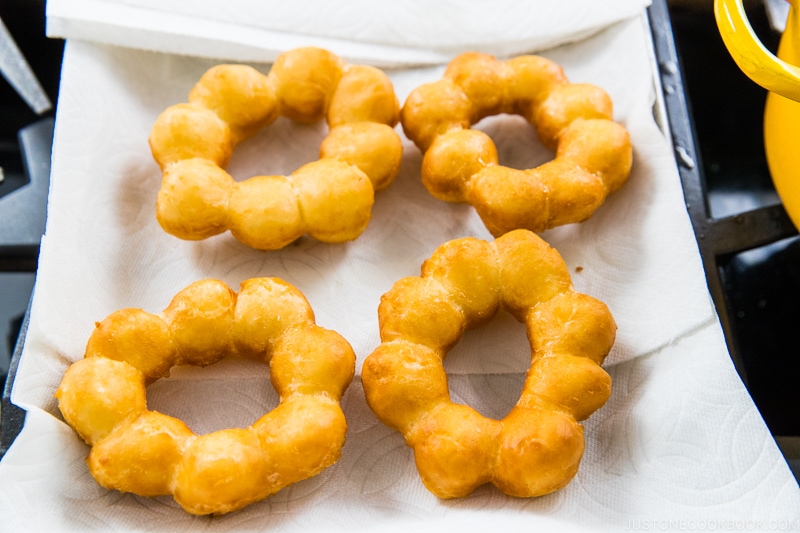
To Glaze
- While the donuts are still hot, dip each one into the glaze, making sure to coat both sides well. Tip: Don't wait until you fry all the donuts. Deep-frying and glazing at the same time gets hectic, so find a partner for this step.
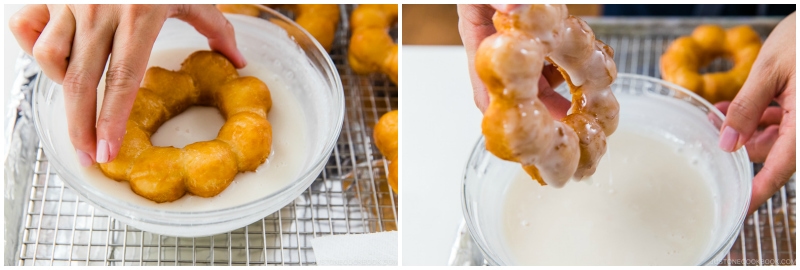
- Place the glazed donuts onto the prepared rack to allow the excess glaze to drip down. The glaze will set and harden on the donuts after 30 minutes.
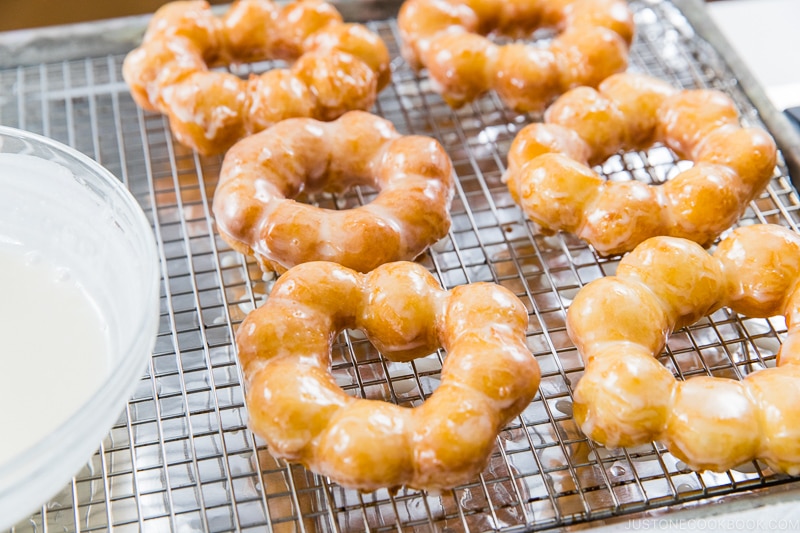
- After glazing 12 donuts, you can add 1 Tbsp matcha green tea powder to the leftover glaze. Whisk really well to combine.

- Dip the other donuts into the matcha glaze. Place them onto the rack to allow the excess glaze to drip down. The glaze will set after 30 minutes.
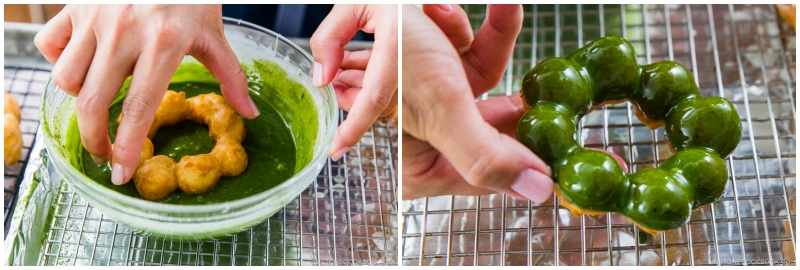
To Serve
- Just like any other deep-fried food, it’s best to eat the donuts while they are warm. Enjoy!
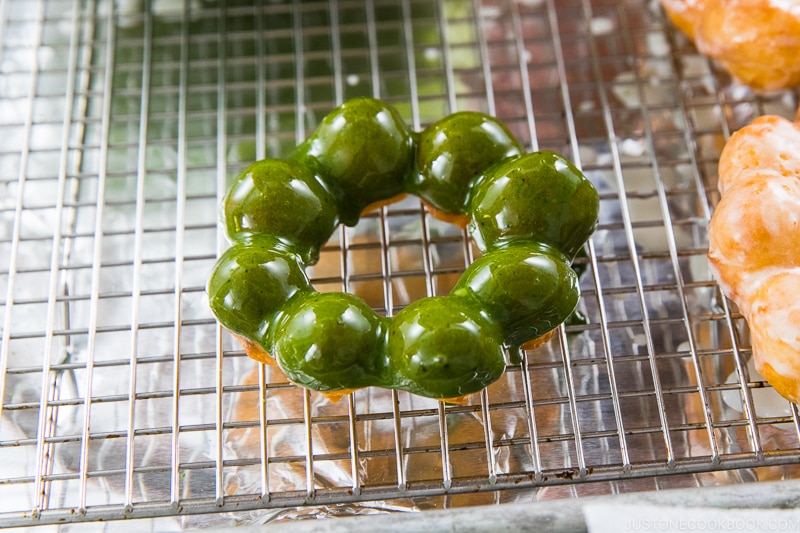
To Store
- Enjoy the donuts on the same day you made them. You can keep them at room temperature for a day in an airtight container. Reheat in the microwave for 15–20 seconds before eating.
Notes
- Oil: Avoid using vegetable oil (read my post). Please adjust the amount of the oil based on how wide and tall your pot is. My Dutch oven is 3.5 QT and I used 1 QT (1000 ml, 4 cups) of safflower oil. The Dutch oven is heavy and thick, and it conducts and retains heat very efficiently. The high sides also help prevent splatters during frying. What to do with leftover oil? Please read this post.
- Helpful Tools: Stand mixer, dough scraper/pastry card, kitchen scale, thermometer, Dutch oven or heavy-bottomed pot. Please read the post.
Nutrition
Calories: 193 kcal · Carbohydrates: 29 g · Protein: 2 g · Fat: 8 g · Saturated Fat: 2 g · Trans Fat: 1 g · Cholesterol: 22 mg · Sodium: 35 mg · Potassium: 37 mg · Fiber: 1 g · Sugar: 13 g · Vitamin A: 127 IU · Vitamin C: 1 mg · Calcium: 18 mg · Iron: 1 mg